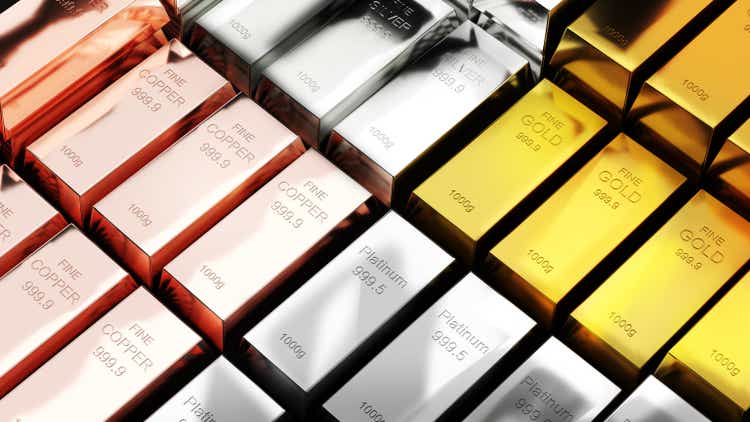
Oselote
Since I last profiled A-Mark Precious Metals (NASDAQ:AMRK) on Seeking Alpha, they have completely transformed, generating ~$400m of EBITDA, acquiring new streams of revenue, and strengthening margins via vertical integration. The company has expanded from a low-margin precious metals wholesaler to a higher margin DTC retailer. I believe A-Mark remains a compelling value investment at $29/share.
Business Overview
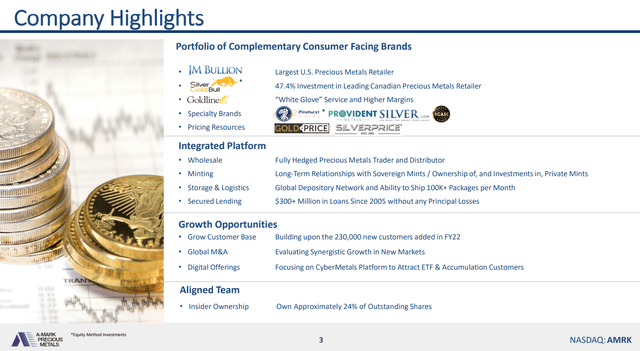
A-Mark Overview (A-Mark Investor Presentation)
A-Mark is a vertically integrated precious metals dealer selling gold and silver bullion. It is important to understand that while A-Mark is selling a commodity, they completely hedge their inventory to eliminate price exposure (the latest 10-K stated less than $3m of their $741m inventory was subject to price risk.)
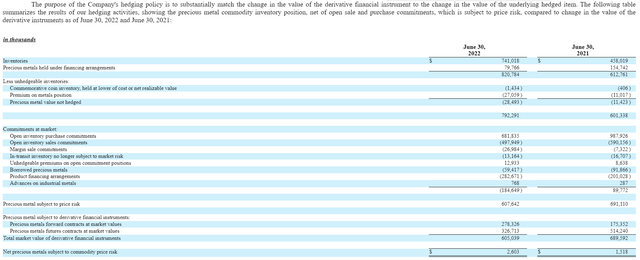
A-Mark Inventory Hedging (AMRK 2022 10-K)
Income is primarily generated by charging a premium to the physical price of gold and silver products. Therefore, the business grows by increasing sales and margins. In times of higher demand, premiums spike, which has recently resulted in significant profitability for A-Mark. While many investors are cautious with the precious metals space, A-Mark offers exposure to the commodity without being specifically tied to price volatility. The current business platform is comprised as follows:
Supply – A-Mark sources precious metals to sell through its wholesale and direct-to-consumer channels. The company has historically sold 30%+ of the total product distributed from the major sovereign mints (US Mint, Royal Canadian, Perth, etc). From 2019 to 2021, production of US Silver Eagles and US Gold Eagles substantially increased. Despite the ramp in production, the mints are still struggling to meet demand (US, Perth mints see renewed demand for gold bullion; Aussie silver shines bright) (Congressional complaint leveled at Mint bullion program). The undersupply from this key channel forces A-Mark to buy more gold and silver eagles on the open market. To alleviate some of the supply pressure, the company has invested in two privately-owned mints:
- Silvertowne Mint – wholly owned mint supplying exclusive product for distribution. Product supplements total inventory, which improves sales margins.
- Sunshine Mint – A-Mark has 44.9% minority investment in the Sunshine mint, which provides silver blanks to the US Mint for minting Silver Eagles, strengthening the relationship.
Wholesale – A-Mark sells wholesale product to institutional clients and retailers. The wholesale segment completed 108k tickets in FY22 for $6.0B revenue (~$56k/ticket). An additional $1.6B of inventory was transferred internally to the DTC segment. Margins in the wholesale segment hovered around 2% in FY21 and FY22, versus less than 1% historically. Forecasting margins quarter-to-quarter is very difficult due to the significant fluctuations in supply and demand; however, we believe A-Mark’s recent capital allocation has permanently improved wholesale margins, which we discuss later.
Direct to Consumer – A-Mark’s DTC customers are retail buyers – the segment filled 859k tickets in FY22 for $2.1B revenue (~$2.5k/ticket). Gross Margins in the DTC segment hovered around 8% in FY21 and 7% FY22, vs 10% pre-Covid when the higher-margin “Goldline” was the company’s only DTC channel. Since 2020, the company has acquired and invested in multiple DTC channels to increase and diversify their customer-base:
- Goldline – Owned since 2017, this channel advertises heavily on FOX NEWS / FOX Business (Glen Beck is spokesman) and targets higher net worth retirees. Predictably, this business does best in times of political tension.
- JMBullion – acquired this mass-market platform in 2021 (JMBullion, Provident Metals, Silverprice.org, Goldprice.org, Silver.com). The typical retail customer for this business is younger and buys in smaller size than Goldline. This is the largest US retail platform with APMEX as the main competitor.
- Silver Gold Bull – Recent minority acquisition to expand sales primarily in Canada and Southeast Asia, with option to boost ownership to 75% in 2024. Sales outside of the US and Europe represented ~11% of FY22 revenue, suggesting international growth could be material.
- Pinehurst – This business grades coins and sells to collectors at substantial premiums. They vet the A-Mark inventory to select the best pieces and capture the highest value.
- Buy Gold and Silver Coins (under LOI) – This business will target the most price sensitive retail buyers. Management indicated they received a bargain price as the owner approached A-Mark seeking to exit the business.
Secured Lending – The final vertical for A-Mark, the secured lending business originates and acquires loans to dealers, investors, and collectors backed by bullion. The company has extended over $300m of loans since inception without a single loss of principle. There was $126m of outstanding loan value (65-75% LTV) at Jun-22 and $11m of corresponding interest income in the TTM period. This business was primarily funded through a notes offering in 2018.
Capital Allocation
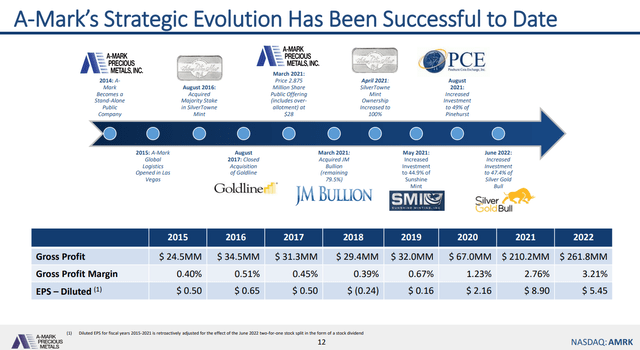
A-Mark Strategic Evolution (A-Mark Investor Presentation)
A-Mark has completed several strategic acquisitions that increase market penetration and improve profit margins. Their vertical integration and expanded DTC strategy has transformed the business. A-Mark has asserted that earnings are best in a volatile precious metals market, so I wanted to prove the business is not simply benefiting from increased volatility in precious metals pricing. I reviewed Gold and Silver volatility (CBOE Silver ETF Volatility Index (DISCONTINUED), CBOE Gold ETF Volatility Index) vs. A-Mark’s wholesale margins, and found some interesting data points:
- From Jul–Dec 2019, A-Mark wholesale margins were 0.5%.
- From Oct–Dec 2020, volatility was higher, and margins increased to 0.9%.
- From July–Dec 2021, Gold and Silver volatility was almost identical to the 2019 period, yet wholesale margins did not revert to 0.5%, instead they were nearly 4x stronger at around 2.0%.
The fundamental difference is explained by A-Mark’s recent acquisitions and investments:
- JMBullion – Acquired in March 2021, JMBullion increased the DTC volumes and provided a large channel to move wholesale product. Owned mint product is supplied to JMB which increases pricing power over peers. With ~20% of wholesale volume moving to the internal DTC segment, A-Mark can be more selective on wholesale counterparts, permanently improving margins. Buying the business for an implied $174m seemed to either be a steal on $62m of 2020 pretax income, or an egregious overpay based on $4m of 2019 pre-tax income. The DTC segment generated $84m pre-tax in their first full year of owning JMB, and the boost to wholesale margins has been eye-popping.
- SilverTowne Mint – Acquired majority stake in the mint in 2016. In April 2021, A-Mark acquired the remaining 31% of Silvertowne. The mint was producing 175k ounces/week pre-2020, vs 1m ounces/week today (per Q4-22 conference call). This acquisition provides low-cost products to move through both wholesale and DTC segments at higher margins. A-Mark’s total FY22 volume of 132.2m silver ounces is well-supported by internal production.
- Goldline – A-Mark bought this money-losing business for $10m in 2017 and transformed the operation prior to the demand spike in 2020. While not initially profitable as a segment, Management took a more holistic view of business driven to the other channels as a result of the Goldline acquisition (Greg Roberts, Q2-20 conference call):
“If you factor in all of the business that Goldline is doing on its own as well as what we call cross benefits between the units, whether it be logistics, whether it be trading, whether it be CFC, finance, I think that if we look at — we and management tend to look at Goldline macro as to how it affects the whole business and the benefits that some of the other business lines are getting from having Goldline. And if we factor all of that in, I think we’re very close to a breakeven at Goldline.”
Goldline proceeded to earn more than the acquisition price in subsequent quarters as business accelerated. This perspective helps drive home just how valuable the JMBullion acquisition was in early 2021.
- Silver Gold Bull – The deals keep rolling, with A-Mark increasing their stake in Silver Gold Bull (from 7.4% to 47.4%) at slightly more than a 4x multiple ($110m implied value, $26.3m TTM Mar-22 pre-tax income).
- Buy Gold and Silver Coins (BGASC) – Most recently, A-Mark announced a deal to acquire Buy Gold And Silver Coins (BGASC) for $4.5m, which had over $200m in FY21 sales. Management highlighted this would be a slightly lower margin customer than JMBullion, but even bringing it to 5% gross margins inside the A-Mark model would suggest the payback time will be measured in months, not years. BGASC will also become a wholesale customer, adding even more synergy to the acquisition.
- Pinehurst – A-Mark increased its minority stake (from 10% to 49%) in August of 2021. The acquisition added exposure to niche collectors of graded coins and provides a channel to upsell the highest-quality silver eagles before disseminating remaining coins through DTC and wholesale channels.
A-Mark has created an ecosystem of businesses that benefit from each other through their increased access to product, internal synergies, and cross-selling, which creates a wide moat in a DTC business that will be hard to assail. Management has repeatedly stated they are “the acquirer of choice” for retail targets, giving them the ability to continue selectively growing through acquisitions at very attractive multiples.
Additional Upside
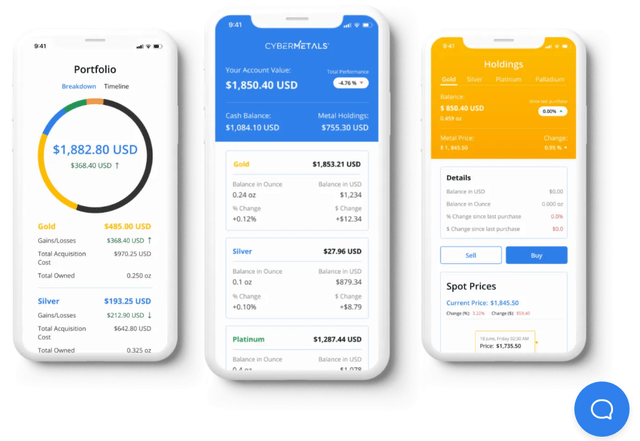
CyberMetals Platform (CyberMetals Website)
In addition to being attractive in its current state, A-Mark is making a play for a much larger piece of the global gold and silver ETF pie. A-Mark has launched Cyber Metals, a platform for users to replace ETF holdings with deposits backed by actual bullion. For many investors, the ability to hold investment dollars in this form versus traditional ETFs is very attractive, giving them the ability to convert to physical product at any time. Company materials point to the $100B+ residing in leading gold and silver ETFs, and trillions in gold and silver assets held globally. I generally despise TAM arguments and am skeptical that a large portion of the market will convert to Cyber Metals in the near term. Three months after the commercial launch, only $3.7m AUM resided on the platform.
At worst, this will be one more piece of the customer experience in the A-Mark ecosystem, and at best, could result in a new earnings stream for shareholders. Storage rates are currently 0.12-0.3% per annum, suggesting $1b+ of AUM might be necessary before earnings become material. This product also seems like it would appeal to investors who have flocked to cryptocurrencies in the past decade, providing easy access to a digital asset protected from central bank actions. Meaningful inroads by Cyber Metals with the ~$1T crypto market could be very material to A-Mark.
Valuation Approach
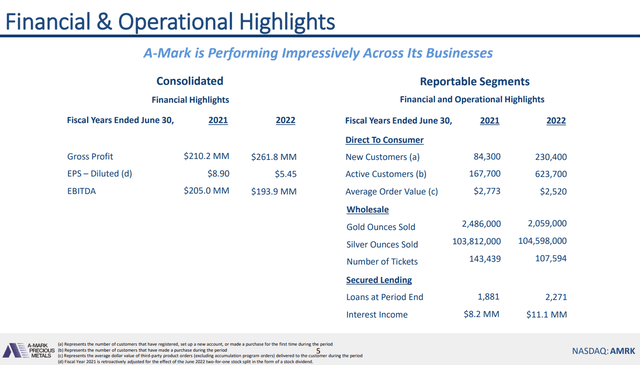
A-Mark Results (A-Mark Investor Presentation)
Valuing A-Mark is difficult, and no similar public comparisons exist. Sales multiples are useless for such a low margin and lumpy business, especially given revenues are a function of commodity inputs (silver and gold) even though the business hedges price risk. Additionally, the roughly $300m of net income generated since the beginning of Covid looks like peak earnings, making investors nervous to put any meaningful multiple on recent results.
Analyzing book value highlights how A-Mark has grown its asset base. A-Mark has compounded common equity value at a rather consistent ~10%/quarter since Covid began, with a notable intangible jump after the JMBullion acquisition in Q3-21. Inventory and A/R lead this growth, while the short-term trading credit to fund inventory drives liabilities. The increasing book value captures the durable worth being created before considering the additional intangible benefits, like being able to pay $4.5m for a platform that should be worth many times more in the hands of A-Mark’s Management. On top of compounding at 10% per quarter, we believe Management has proven themselves incredibly capable at adding additional businesses at accretive multiples, making ~1.3x book an undemanding valuation, when it traded at that level for years prior to the recent transformation.
From an annual earnings perspective, we see the following as the “new normal” for A-Mark’s baseline business model, though it may over or under-shoot quarter to quarter:
| Business Line | Revenue | Gross Margin | Gross Profit |
| Wholesale | $6B | 1% | $60m |
| DTC | $2B | 6% | $120m |
There will be other smaller pickups from the small Secured Lending Segment, their equity investments, transportation and storage, etc. But the core business can comfortably substantiate the current SG&A burden of ~$70-80m with $100m+ of EBITDA.
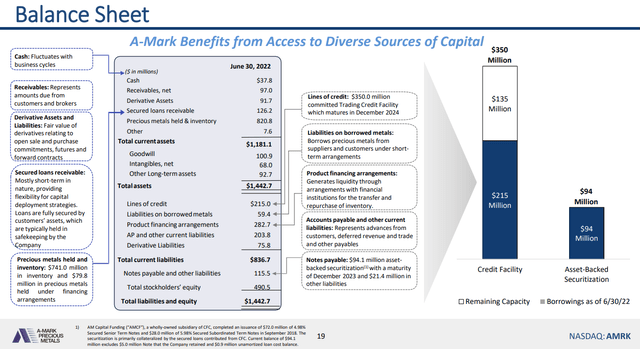
A-Mark Balance Sheet (A-Mark Investor Presentation)
From an Enterprise Value (“EV”) perspective, we believe A-Mark incorrectly appears less attractive due to the large trading facility and secured notes, both of which screen as debt, but are backed by corresponding assets on the A-Mark balance sheet (inventory and secured precious metals loans). The company screens with a $1.2B EV, but I argue you should back out the following:
- $215m trading facility, $283m product financing arrangements, and $59m liability on borrowed precious metals, which are backed by $741m of inventory and $80m of metals held under financing arrangements and $94m notes payable are offset by $126m secured loans receivable.
After removing these debt amounts and subtracting $38m of cash, A-Mark has an EV of ~$700m, 7x or less our “new normal” EBITDA estimate for the business. Additionally, interest expense is offset by loan interest income and the business requires almost no CapEx beyond growth acquisitions. The operating income conversion to FCF approaches 100%, but is obscured by quarter-to-quarter fluctuations in working capital.
Valuation
Growing platforms in the process of rolling up their sector usually trade at extreme multiples, like popular compounders Pool Corporation (POOL), SiteOne Landscaping (SITE), and more. All display the ability to reinvest capital in their business at a high rate of return. We believe a 15x multiple on normalized FCF would be an undemanding valuation for such a compounding business. $100m of core earnings after SG&A, adjusted for a 25% tax rate and no material CapEx or interest expense is $75m, or $1.125B at a 15x multiple. Using 25m fully diluted shares, this generates a $45 target price, giving no credit for upside from future acquisitions or new products like Cyber Metals. Davidson and Northland maintain $57 and $60 price targets on the stock, suggesting this approach is not too aggressive.
Risks
- Insiders historically owned nearly half the business and have been trimming stakes after the stock’s substantial run. This insider selling pressure looks poor on the tape but ignores the >20% ownership remaining in the hands of Management, aligning their interests with shareholders. Director Jess Ravich just bought ~2% of outstanding shares via his controlled holding company, ALJ Regional Holdings (OTC:ALJJ).
- A-Mark relies on relationships with sovereign mints and large institutional buyers in their wholesale segment to generate profits, including their US Mint relationship that goes back over 35 years (FY22 10-K). Any damage to these core relationships could impair profitability.
- Lumpy earnings and cashflow don’t always sit well with Wall Street investors, and it may take time for investors to grow comfortable with improvements in margins being structural. CEO Greg Roberts has stated on the Q2-20 earnings call a long-term vision to build this platform to eventually sell after a few good years of profitability. A sale process seems the most likely catalyst to re-rate shares, without which they may continue to trade at a low valuation.
- Trading volume on A-Mark is somewhat low even for a small cap stock, which makes building a position potentially difficult for larger institutional investors.
- A-Mark has never reported a material error with their hedging program, but any mistakes with inventory and internal hedges could result in a material loss. For instance, A-Mark recently announced a $1.1m settlement due to a previously-undisclosed complaint from the Commodity Futures Trading Commission. The settlement is not material to the valuation, but a reminder that unforeseen risks could arise.
Conclusion
A-Mark has steadily built a moat through their access to cheap bullion, diverse consumer offerings, and highly accretive acquisitions. Management is well aligned through their ownership stake and has shown great skill in recent acquisitions. Continued growth of the DTC business will move more inventory at higher margins. Their tight ties with sovereign mints protect them from displacement, and recent improvements in margins appear cyclical but are structural in nature. We expect the compounding nature of the business will eventually become clear to investors, re-rating shares in line with similar businesses with wide moats.


Be the first to comment